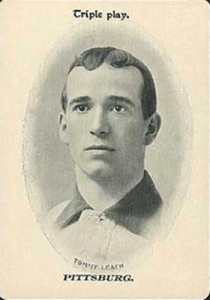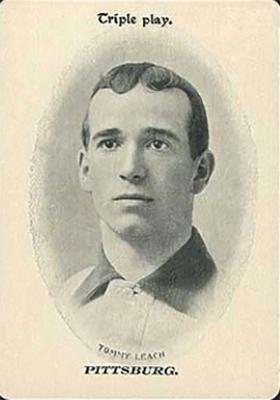Tommy Leach
 Though standing just 5′ 6″ and weighing as little as 135 pounds at the start of his career, “Wee” Tommie Leach was nonetheless one of the better “power” hitters of the first decade of the 20th century. Over the course of a 19-year career in the National League, Leach finished in the top ten six times each in triples, home runs and total bases. Years later, at a dinner in Florida, he explained his surprising long ball proficiency: “Sometimes they played me right in back of the infield. Every so often, I’d manage to drive a ball between the outfielders and it would roll to the fence. I was pretty fast, and by the time they ran the ball down and got it back to the infield, I’d be home. I don’t ever recall getting a home run on a ball that hit outside of the park.” Leach was exaggerating, but not by much: of his 63 career home runs, 49 were inside-the-park, placing him second on the all-time list behind Sam Crawford.
Though standing just 5′ 6″ and weighing as little as 135 pounds at the start of his career, “Wee” Tommie Leach was nonetheless one of the better “power” hitters of the first decade of the 20th century. Over the course of a 19-year career in the National League, Leach finished in the top ten six times each in triples, home runs and total bases. Years later, at a dinner in Florida, he explained his surprising long ball proficiency: “Sometimes they played me right in back of the infield. Every so often, I’d manage to drive a ball between the outfielders and it would roll to the fence. I was pretty fast, and by the time they ran the ball down and got it back to the infield, I’d be home. I don’t ever recall getting a home run on a ball that hit outside of the park.” Leach was exaggerating, but not by much: of his 63 career home runs, 49 were inside-the-park, placing him second on the all-time list behind Sam Crawford.
Thomas William Leach was born on November 4, 1877, in the village of French Creek, in western New York, but his family moved to an Irish neighborhood in Cleveland when he was five years old. The Leaches were neighbors of the Delahantys, a family that produced five major leaguers. Enthusiastic about the tremendous success of Ed Delahanty, Tommie’s father encouraged Tommie by saying, “If Ed can do it, so can you.” Tommie was apprenticed in a printer’s shop, but played baseball constantly, and was soon employed as a third baseman with a succession of minor league teams: Hanover, Pennsylvania (Cumberland Valley League) and Petersburg (Virginia League) in 1896; Youngstown, Ohio and Geneva, Ohio (both Interstate League) in 1897. He did not distinguish himself at the plate at any of these stops.
His big break came in 1898 when he hit .325 in 97 games with Auburn of the New York State League, and led the circuit in runs (85) and home runs (5). In August owner John Farrell sent Leach to the New York Giants for a two-week trial, but Giants owner Andrew Freedman promptly returned him, saying, “Take your boy back before he gets hurt. We don’t take midgets on the Giants.”
Soon thereafter, Louisville owner Barney Dreyfuss acquired the 20-year-old Leach for $650. Despite spending several weeks on the 1898 roster, he played in just three games, making three errors against just one hit. Leach started the 1899 season with the Colonels, but was farmed out to Worcester after making five errors in his first game. After a six-week stint for in the Eastern League, he returned to Louisville and hit .288 for the season, appearing in 25 games at shortstop and 80 at third base.
When the core of the Colonels moved to Pittsburgh as part of a merger of the teams in 1900, Leach became a Pirate. Initially, it appeared likely that Leach’s career would fizzle out-the Pirates’ incumbent third baseman was Jimmy Williams, who had hit .354 as a 22-year old rookie in 1899. Tommie struggled as a reserve infielder in 1900—.213 in 160 at bats—but when Williams jumped to the fledgling American League for 1901, Leach was given the third base job, and he would soon be one of the best in the National League. In his first season as a regular, Leach hit .305 for the first of the Pirates’ three straight pennant winners.
Tommie Leach became a full-fledged star in 1902. Usually batting third ahead of Honus Wagner, the right-handed hitting Leach hit .278, but led the league in both home runs (6) and triples (22) and finished second with 85 RBI. The six home runs were the lowest by a champion in the twentieth century, but the triples established Leach as a leading power hitter.
After the 1902 season, several members of the Pirates, including Jesse Tannehill and Jack Chesbro, jumped to clubs in the new American League. Leach also accepted a bonus from the AL, and tried to use the deal to get more money out of the Pirates. When this didn’t work, he told Barney Dreyfuss, “Don’t come around bellyaching if I do [jump].” In the event, Tommie backed down and returned the bonus. During the peace negotiations between the leagues, his contract with the Pirates was upheld.
The following year, to go along with seven home runs (second in the league, and all inside-the-park), Leach also hit 17 three-baggers. In the first modern World Series, Tommie hit .273 and slugged four triples, a total that has not been matched in a Series since. Like many of the Pirates, he did his damage early on, including two singles and two triples (both of which merely had to bound 250 feet into the roped off crowd at Boston’s Huntington Avenue Grounds) in the first game, but he was hitless (0-13) in the final three games, all losses.
Though still a youngster, Leach was a leader and a star on these great teams. In July 1904, player-manager Fred Clarke received a serious spike wound that required surgery and kept him away from the team for six weeks. When Honus Wagner turned down the role, Tommie was named acting manager. That he was 27 years old, and the smallest player on the team, shows the extraordinary confidence Clarke had in him.
Tommie had two mediocre offensive seasons in 1904 and 1905, hitting .257 each year. In a game against St. Louis in the latter season, he sustained an injury that had a significant impact on the remainder of his career. He laid down a bunt that was fielded by Cardinals first baseman Jake Beckley, who sailed the ball a yard over the head of pitcher Jack Taylor, covering first base. By the time Beckley retrieved the ball, the fleet-footed Leach was rounding third and heading for home. Rather than risk another lousy throw, the scatter-armed first baseman decided to race Tommy to the plate. Beckley dove head first from one direction while Leach slid feet first from the other, and in the resulting collision Leach sustained two broken ribs. Leach had difficulty throwing when he returned, and he began to play the outfield for the first time. Over the next few seasons he played both third base and centerfield; beginning in 1909, he was a full-time centerfielder.
Tommie hit .303 in 1907, good enough for fourth in the league, stole a career-high 43 bases, and scored 100 runs for the first time in his career. After hitting just .259 in 1908, the next year, he led the league with 126 runs scored and was second with 6 home runs to help lead the Pirates to another pennant.
The 31-year-old Leach was starting to go bald, and just before the World Series he shaved his head completely and applied liniment to his scalp in hopes of warding off his hair loss. Detroit third baseman George Moriarty tried to embarrass Tommie during the Series by pulling the cap right off his head, but Tommie had the last laugh. He led his team with nine hits, four doubles, and a .360 batting average as Pittsburgh took the title in seven games.
After a solid .270 campaign in 1910, but an injury-plagued year in 1911 (.238), Leach was dealt with Lefty Leifield to the Cubs for Artie Hofman and King Cole in June 1912. Tommie was not through as a productive player. He led the league with 99 runs scored in 1913, and he hit seven home runs in 1914. He moved on to Cincinnati for his last full season in 1915 and managed just a .224 average. He spent several more years in the minor leagues, returning briefly to the Pirates in 1918 when the Great War depleted most major league rosters.
Tommie was often rumored to be a managerial candidate. He was contacted by the Reds to manage in 1908, but the Pirates demanded compensation and terms could not be reached. When Clarke resigned after the 1915 season, Leach was rumored to be in line for the Pirate job, but it went to Jimmy Callahan. He was a player-manager for Rochester in the International League in 1916, and managed for several years for various teams in the Florida State League in the 1920s. From 1935 to 1941, he was a scout for the Boston Braves.
Tommie suffered tremendous personal loss during his baseball career. He lost his first wife to pneumonia in 1908 and a second to illness in 1911. His third wife, Sara Darling, survived him. He had a son by his first marriage and a daughter by his third.
In 1914, Tommie bought citrus property in Haines City, Florida, and lived the rest of his non-baseball life there. He was a popular figure in the area for many years, and was active in local baseball activities. He died in Haines City in 1969 just shy of his 92nd birthday, the second to last surviving player from the 1903 World Series.
NOTE: A version of this biography first appeared in Tom Simon, ed., Deadball Stars of the National League (Washington, D. C.: Brassey’s, Inc., 2004).
Last revised: January 26, 2022 (zp)
Sources
In preparing this biography I made use of many issues of The Sporting News during Leach’s playing career. Other more specific sources included:
DeValeria, Dennis and Jeanne Burke. Honus Wagner. Henry Holt, 1995.
Lieb, Fred. The Pittsburgh Pirates. Putnam, 1948.
Obituary. Haines City (Florida) Herald, date unknown.
Obituary. The Sporting News. October 1, 1969.
Ritter, Lawrence S. The Glory of Their Times. Macmillan, 1966.
Full Name
Thomas William Leach
Born
November 4, 1877 at French Creek, NY (USA)
Died
September 29, 1969 at Haines City, FL (USA)
If you can help us improve this player’s biography, contact us.


